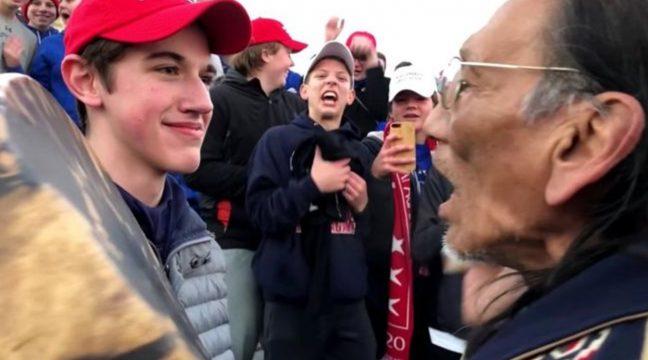Ask any political pundit, blogger or journalist about what happened Jan. 18, 2019, and you’re bound to get one of three responses.
Some would rant about the abuse of young, conservative men in pursuit of attacking President Trump. Others might deliver a half-hearted apology for leaping upon the infamous video, and the MAGA hat-wearing teens within it, with a little too much gusto. Still others would stare back with a mystified kind of speechlessness.
For many Americans, video after investigation after interview had made an incident that seemed clear become, for lack of a better word, murky.
What should we be taking away from that fateful clash of protesters? The answer, despite the best efforts of several Fox News commentators, is hardly clear. Coverage of the resulting furor has merely tipped the scales from one side to the other and back again. Were the Covington Catholic boys guilty of instigating hate and conflict that day, or were they simply innocent bystanders caught in the “liberal media” firestorm?
A $250 million lawsuit against The Washington Post, filed by the parents of Nick Sandmann, seems to imply the latter. Days after the results of a Covington Catholic–funded, third-party investigation found “no fault,” the scales seemed to tip again. Not only was the media wrong in covering the debacle, they had irreparably wronged the boys, forever tying them to that moment on the National Mall.
There’s a lot to unpack here — and few have dared to even begin doing so. Whether in hesitation of misstepping again, or out of fear of being “cancelled,” most media organizations (excluding FOX, of course) have let the discussion simply fade away.
But the murkier the story gets, the more we should refuse to let it lie untouched. There are lessons to be learned from the Covington debacle. The idea that culpability and innocence in this scenario are mutually exclusive is not just over-simplified — it ignores the responsibility we have to learn from moments like these.
On Jan. 18, the Covington Catholic boys were returning from a pro-life rally on the National Mall, part of a school field trip. Across the mall, a group of Black Israelites — an extremist group which believes mainstream Jews are “imposters,” and the “descendants of Satan” — began taunting the boys with racial slurs and provocative questions.
Soon, the groups engaged each other. Some of the Covington Catholic boys began to argue with the Black Israelites, giving the group exactly what they wanted — attention.
When Omaha National Elder Nathan Phillips approached the two groups, he maintained that his only goal was to wind down the conflict by drumming. Yet, that was where the infamous video began — capturing the tense moment where Phillips, resolute over his drum, stood eye to eye with jeering young men, some wearing MAGA hats.
It’s always been ‘this bad’: White supremacy blinds white people from recognizing racial injustice
One student — Nick Sandmann — stood silently as the drumming continued, smirking. Behind Phillips, several students began to imitate his chanting, flinging their hands in a mockery of a tomahawk chop.
America made up its mind immediately, superimposing ourselves onto the conflict. Phillips was no longer a Native American elder, and Sandmann was no longer a young Catholic boy. They became proxies for political polarization in this country.
And what better way to frame the evils of the Trump administration than through the image of a smirking white man, confident in his privilege? What better way to juxtapose our situation to theirs than through Phillips attempting to drum out peace in a sea of MAGA hats?
Conservative pundits will insist our willingness to see ourselves in the Covington debacle is a result of “liberal bias.” But “liberal bias” has backed those same media organizations into painful apologies, recanting almost all of their coverage of the event, to the gleeful applause of President Trump.
Trump’s support of sexual abusers symptomatic of deep-seeded American rape culture
Yet, Sandmann’s lawsuit against The Washington Post — frivolous as it is — cements the very perspective Covington Catholic accused the media of transposing in the first place: by wearing the MAGA hats, the Covington boys stood for something far greater than themselves — ideas that went beyond the immaturity of school boys on a field trip.
If, during the altercation, the Covington boys were not aware of their symbolism, they seem to have embraced it eagerly now. Drawing support from the president against “fake news” while hiring a conservative public relations firm, Sandmann’s suit against The Washington Post has absolutely nothing to do with legitimate claims of defamation. It is an attempt to stay relevant, to embrace victim-hood and to highlight the peril of being a young, Christian, white man in America.
The assertion that major news organizations were intending to target young white men simply for being white men in America is absolutely ridiculous. Anger and outrage came down upon that video because they were young, white men gleefully sporting a hat that has become impossible to separate from the policies of its president.
Again, the discussion on the MAGA hats oscillates between a familiar dichotomy. Either the hats are a symbol of racism and discrimination, or they are merely a political item — a way to express support for a candidate. There is no room for nuance in this discussion — as if symbols, by their nature, cannot be complicated.
Conservatives’ self-victimization on college campuses is getting old
The funny thing about symbols is that they rarely rely on anything intrinsic to themselves. Their interpretation by others is what matters. Intention, in all of these discussions, seems to matter least of all.
A statue of a slave-owning Confederate general is not evil simply because it was made of stone — it is oppressive because of the endless shadow it casts over the black Americans who walk under it. A Nazi salute, however misguided, is not evil because the young men in Baraboo were somehow, secretly, Nazis — it was evil because the sight of an outstretched hand, lifted angrily by white men, is a gut-wrenching pain in the heart of every Jew who sees it.
Regardless of intention, the symbol persists. By erecting statues, by saluting a cameraman, by simply wearing hats — we tie ourselves to an idea whose essence cannot truly be conveyed in any other way. So, indeed, the MAGA hat might not be the new KKK hood, but it is far from an innocent, untarnished declaration of political affiliation.
Perhaps the Covington Catholic video is too complicated for us to extract a lesson from its content. Maybe it was, at its core, a messy, complex clash. We can hardly fault the boys for engaging with the Black Israelites. Every week, dozens of college-age students engage fruitlessly with similar speakers on campus.
Increase in white supremacy on campuses nationwide emblematic of social climate in America
But, despite their intentions, despite their age, there is a thread of awareness running through all of this. The students knew what they were there for. They knew that mocking the Native American drummer was wrong. They knew the space they were occupying — the defense of white men, the control of women’s bodies — because it had been teased out of them so easily minutes before. They knew exactly what the MAGA hat meant to those around them, even if they didn’t believe in its meaning themselves.
The students could have walked away. They could have refrained from imitating tomahawk chops and racist hollering. They could have, as Phillips did, realized the pointlessness of engaging with extremists over something as silly as white fragility.
But they didn’t. And the contrasting image of two figures, caught in a deadlock, a drum between them, is pressed into the minds of the American people. It is the ugliness of racism and miseducation, in physical form. It is a glaring red flag — one we should unapologetically heed.
Julia Brunson ([email protected]) is a senior majoring in history.





















